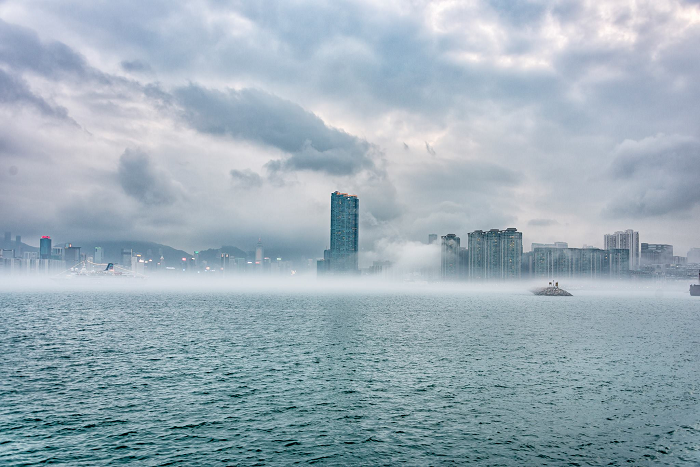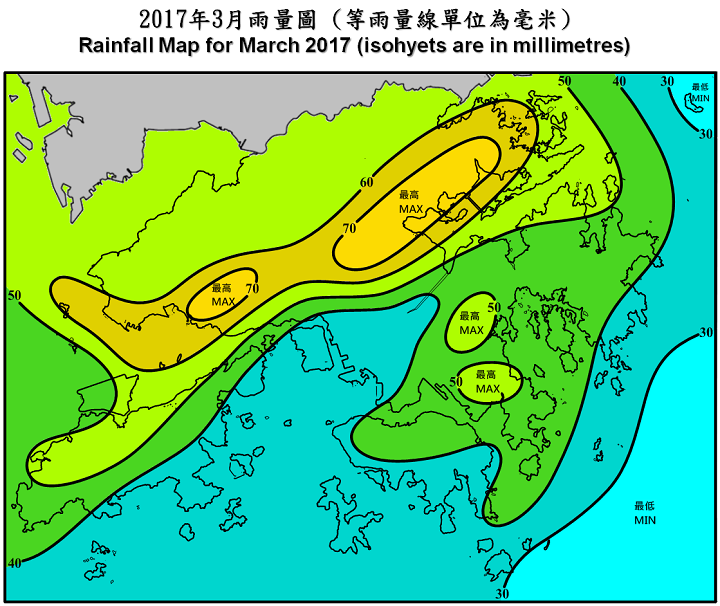The Weather of March 2017
5 April 2017
Going into a season of transition between the northeast monsoon and the mild and humid maritime airstream over the south China coast, local weather in March 2017 was marked by fluctuating temperatures. While the monthly mean temperature of 19.3 degrees was only 0.2 degree above the normal of 19.1 degrees, total rainfall in the month, 48.0 millimetres, was about 42 percent below the March normal of 82.2 millimetres. The accumulated rainfall of 75.7 millimetres in the first three months of the year was about 53 percent below the normal of 161.3 millimetres for the same period.
With the northeast monsoon bringing a continental airstream to southern China, the weather in Hong Kong was generally fine and dry on the first four days in the month, with the daytime relative humidity falling below 30 percent on 2 March.
As the northeast monsoon subsided and a maritime airstream set in, the weather turned cloudier on 5 March and a spell of cloudy conditions persisted in the next fortnight. Coastal fog on the morning of 6 March brought the visibility down to around 100 metres at Waglan Island. Meanwhile, a replenishment of the northeast monsoon reached the coast of Guangdong later that day and brought cooler weather over the next couple of days. More than 10 millimetres of rain fell over the northeastern part of the New Territories on 8 March. Under the influence of a moist easterly airstream, there were mist and light rain patches in the next four days. Morning fog on 13 March with visibility below 1000 metres in the harbour was followed by a relatively warm day with sunny intervals.
After another foggy start on 14 March, a cold front crossed the coast of Guangdong later in the morning and brought overcast sky with widespread rain. Easterly winds strengthened and conditions remained rather windy over the next couple of days with cooler temperatures. As the northeast monsoon gradually subsided, a maritime airstream moved in towards the coast of Guangdong and there were some light rain patches and coastal fog in Hong Kong on 17-18 March. Affected by an upper-air disturbance, rain turned heavier on 19 March with more than 30 millimetres falling over the New Territories.
Apart from some mist or fog patches, the cloudy spell ended as the weather in Hong Kong turned fine and very warm on 20-21 March. With abundant sunshine, temperatures at the Hong Kong Observatory climbed to a maximum of 27.6 degrees on 21 March, the highest of the month. The clouds and light rain returned the next day as a freshening easterly airstream brought a replenishment of the northeast monsoon and cooler weather to the coast of Guangdong. As the monsoon winds subsided, there were sunny periods with some mist on 23-24 March. A cold front then moved across the coast of Guangdong on 25 March. Under cloudy sky with some light rain patches, temperatures over the territory fell significantly and temperatures at the Hong Kong Observatory dropped to a minimum of 13.8 degrees the next morning, the lowest of the month and a temperature swing of nearly 14 degrees in a matter of five days.
With a continental air mass spreading to the south China coast, local weather turned mainly fine and dry on 27 March. As a maritime airstream pushed back towards the coast of Guangdong, local weather became warmer and more humid with mist patches over the next three days. While it was foggy on the morning of 31 March, a cold front moved across the coast of Guangdong during the day, bringing cooler and rainy weather with a few thunderstorms to the territory.

There was no tropical cyclone over the South China Sea and the western North Pacific in the month.
Details of issuance and cancellation of various warnings/signals in the month are summarized in Tables 1.1 to 1.3. Monthly meteorological figures and departures from normal for March are tabulated in Table 2.
Warnings and Signals issued in March 2017
| Beginning Time | Ending Time | ||
|---|---|---|---|
| Day/Month | HKT | Day/Month | HKT |
| 14 / 3 | 1015 | 16 / 3 | 0545 |
| 31 / 3 | 1615 | 1 / 4 | 0600 |
| Beginning Time | Ending Time | ||
|---|---|---|---|
| Day/Month | HKT | Day/Month | HKT |
| 19 / 3 | 0705 | 19 / 3 | 0930 |
| 31 / 3 | 0845 | 31 / 3 | 1700 |
| Colour | Beginning Time | Ending Time | ||
|---|---|---|---|---|
| Day/Month | HKT | Day/Month | HKT | |
| Red | 2 / 3 | 0600 | 2 / 3 | 2300 |
| Yellow | 5 / 3 | 0600 | 5 / 3 | 1615 |
| Red | 27 / 3 | 0600 | 27 / 3 | 2115 |
| Meteorological Element | Figure of the Month | Departure from Normal* |
|---|---|---|
| Mean Daily Maximum Air Temperature | 21.7 degrees C | 0.3 degree above normal |
| Mean Air Temperature | 19.3 degrees C | 0.2 degree above normal |
| Mean Daily Minimum Air Temperature | 17.3 degrees C | 0.1 degree above normal |
| Mean Dew Point Temperature | 15.7 degrees C | normal |
| Mean Relative Humidity | 81 % | 1 % below normal |
| Mean Cloud Amount | 80 % | 1 % above normal |
| Total Rainfall | 48.0 mm | 34.2 mm below normal |
| Number of hours of Reduced VisibilityΔ | 50 hours | 65.3 hours below normal§ |
| Total Bright Sunshine Duration | 85.2 hours | 5.6 hours below normal |
| Mean Daily Global Solar Radiation | 10.71 Megajoule / square metre | 0.75 Megajoule above normal |
| Total Evaporation | 67.3 mm | 3.2 mm below normal |
| Remarks : | All measurements were made at the Hong Kong Observatory except sunshine,
solar radiation and evaporation which were recorded at King's Park
Meteorological Station and visibility which was observed at the Hong
Kong International Airport. |
| Δ | The visibility readings at the Hong Kong International Airport are based on hourly observations by professional meteorological observers in 2004 and before, and average readings over the 10-minute period before the clock hour of the visibility meter near the middle of the south runway from 2005 onwards. The change of the data source in 2005 is an improvement of the visibility assessment using instrumented observations following the international trend.
|
* Departure from 1981 - 2010 climatological normal, except for number of hours of reduced visibility |
|
§ Departure from mean value between 1997 and 2016 |
|


| Remarks : | Extremely high: above 95th percentile Above normal: between 75th and 95th percentile Normal: between 25th and 75th percentile Below normal: between 5th and 25th percentile Extremely low: below 5th percentile Percentile and 5-day running average values are computed based on the data from 1981 to 2010 |
